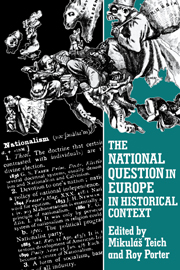Book contents
- Frontmatter
- Contents
- List of maps
- Notes on contributors
- Acknowledgements
- Introduction
- 1 The British Isles: Celt and Saxon
- 2 The making of the French nation
- 3 The national question in Italy
- 4 The roots of the national question in Spain
- 5 Shifting nationalism: Belgians, Flemings and Walloons
- 6 The nation in German history
- 7 Nationalism and nation-state in Germany
- 8 The national identity of the Austrians
- 9 The Czechs
- 10 The national question in Hungary
- 11 The union of Dalmatia with northern Croatia: a crucial question of the Croatian national integration in the nineteenth century
- 12 The national question in Poland in the twentieth century
- 13 Finland: from Napoleonic legacy to Nordic co-operation
- Index
5 - Shifting nationalism: Belgians, Flemings and Walloons
Published online by Cambridge University Press: 30 November 2009
- Frontmatter
- Contents
- List of maps
- Notes on contributors
- Acknowledgements
- Introduction
- 1 The British Isles: Celt and Saxon
- 2 The making of the French nation
- 3 The national question in Italy
- 4 The roots of the national question in Spain
- 5 Shifting nationalism: Belgians, Flemings and Walloons
- 6 The nation in German history
- 7 Nationalism and nation-state in Germany
- 8 The national identity of the Austrians
- 9 The Czechs
- 10 The national question in Hungary
- 11 The union of Dalmatia with northern Croatia: a crucial question of the Croatian national integration in the nineteenth century
- 12 The national question in Poland in the twentieth century
- 13 Finland: from Napoleonic legacy to Nordic co-operation
- Index
Summary
The nationality problem in Belgium, that is, the problem of two language groups living within one state, has dominated political life in recent decades. It has led to a restructuring of the state in a series of revisions of the constitution in 1970, 1980 and 1988. Through these revisions a process of federalization has been put in motion. With the latest revision of the constitution the central unitary state is to give way to a body of federal states, although at the time of writing the process has not been yet completed. The language groups — the Dutch-speaking community in the north and the French-speaking community in the south — are moving more and more towards the development of complete national entities with their own symbols, public holidays and institutions. The question now is whether the old Belgian national identity which in 1830 was so strong that it led to a successful national revolution and to independence, can withstand the centrifugal power of the new nationalist forces. It is possible of course that the appeal of complete separatism has diminished precisely because of the structural reforms recently undertaken and that a new co-ordinating role will be found for the Belgian state.
The question that concerns us in this contribution is how and why the waning of a Belgian sense of identity has come about to the advantage of both a Flemish and Walloon identity.
- Type
- Chapter
- Information
- The National Question in Europe in Historical Context , pp. 128 - 147Publisher: Cambridge University PressPrint publication year: 1993
- 1
- Cited by

